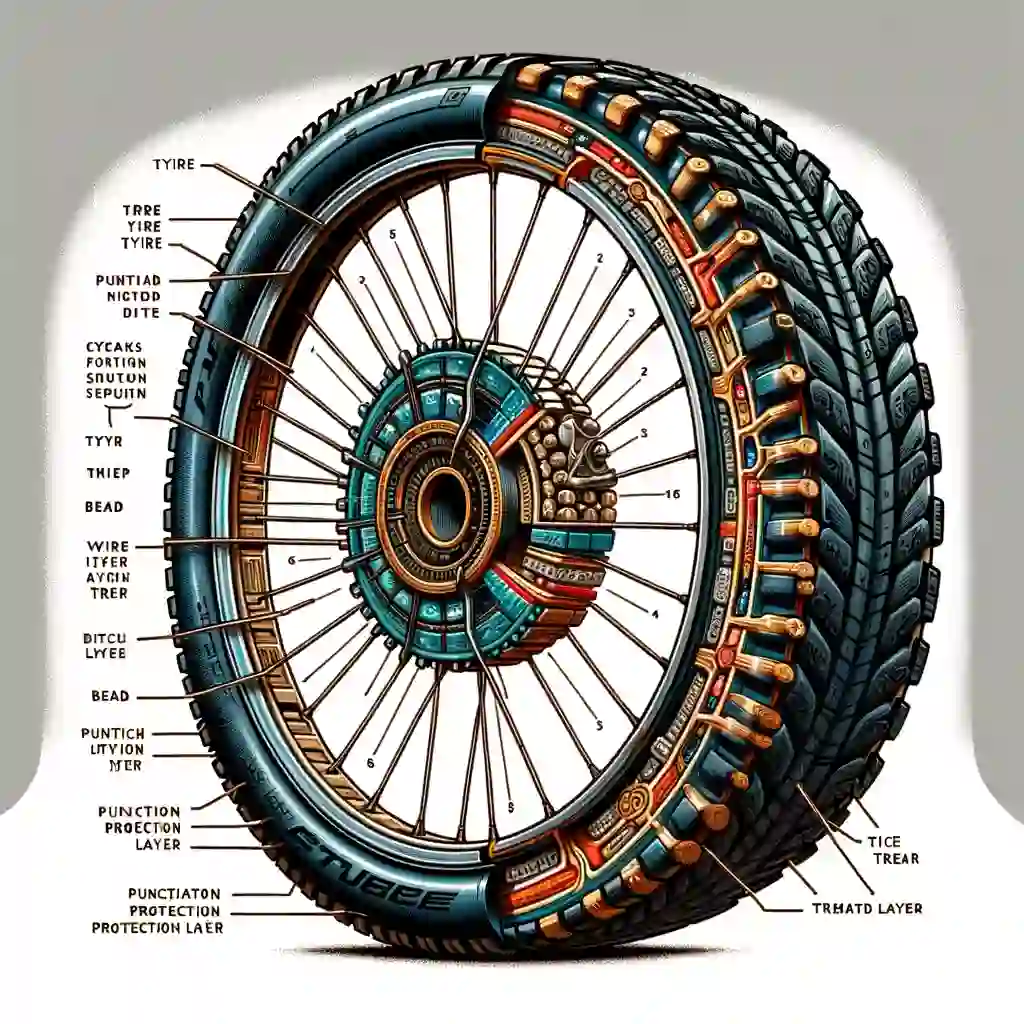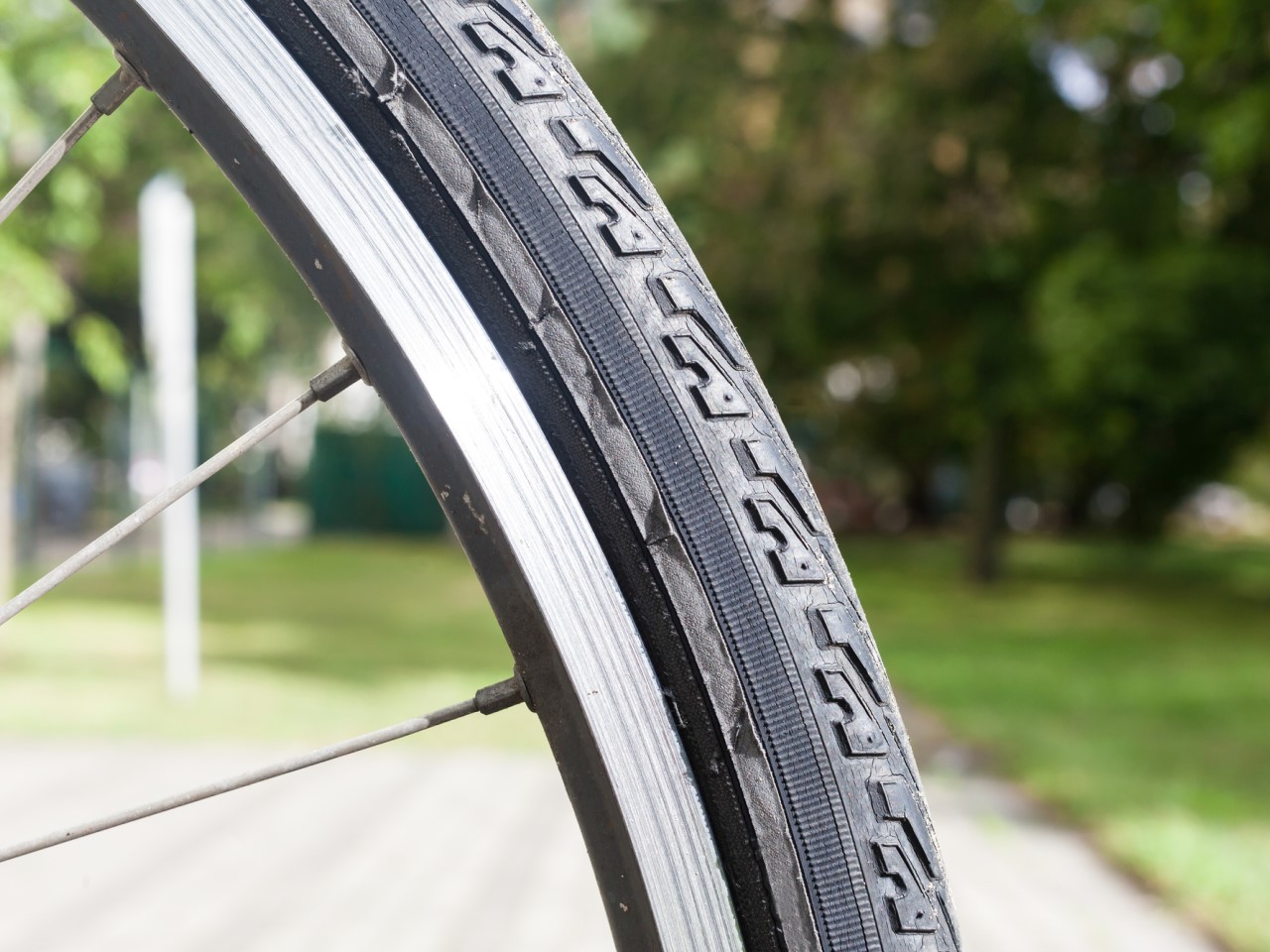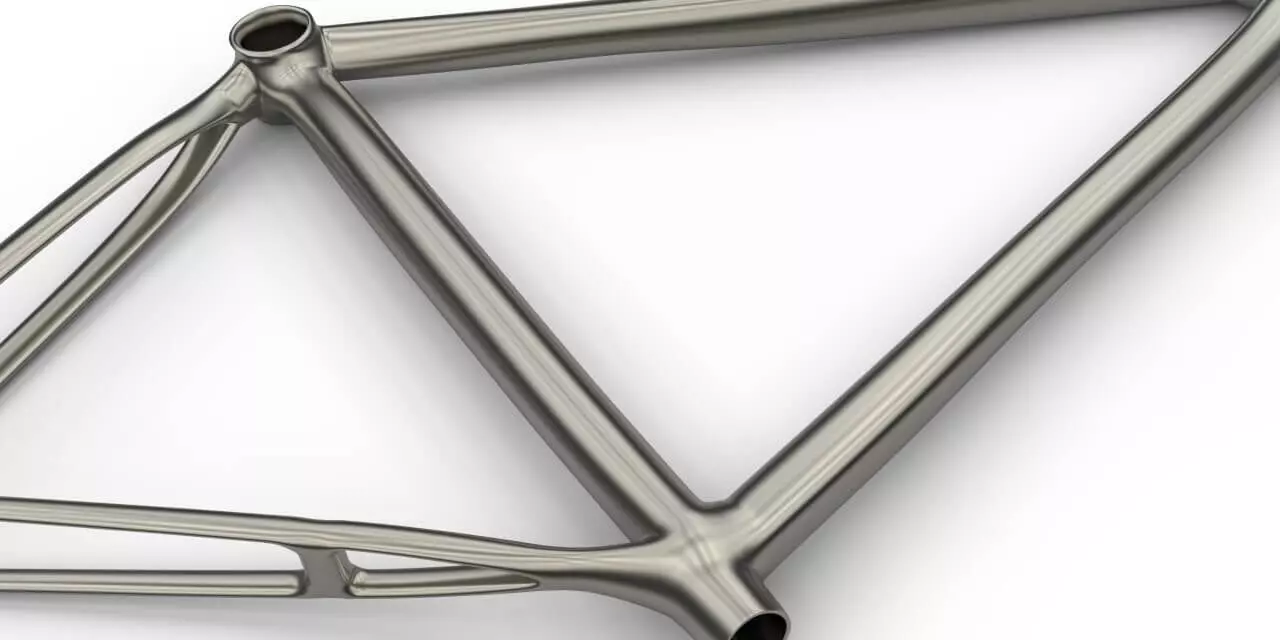Bicycle tires are crucial components for any bike, playing a pivotal role in movement, safety, and overall riding experience. They come in various designs, each differing in structure, tread pattern, and materials. This article aims to provide an insightful overview of bicycle tire aspects, ensuring you make an informed decision for your cycling adventures.
Anatomy of a Bicycle Tire
Understanding the anatomy of a bicycle tire is crucial for selecting the right tire for your bike and riding style. Here’s a look at the various components that make up a bicycle tire:
- Tire Carcass (or Casing):
- Function: The backbone of the tire, providing structure and shape.
- Material: Typically made of layers of fabric, most commonly nylon, coated with rubber.
- Measurement: Quality measured in TPI (threads per inch); higher TPI indicates a denser, often higher-quality casing.
- Bead:
- Role: This is the part of the tire that hooks onto the rim to keep the tire in place.
- Types: Wire beads (heavier, less expensive) and folding beads (made of flexible materials like Kevlar, lighter and more portable).
- Puncture Protection Layer:
- Purpose: Positioned between the carcass and the tread to prevent punctures and flats.
- Variation: Not all tires have this layer; more common in performance-oriented or commuter tires.
- Tread:
- Surface Contact: The part of the tire that makes contact with the road or trail.
- Design: Varies widely, from smooth for road bikes to rugged with deep grooves for mountain bikes.
- Material: Often a mix of natural and synthetic rubber, with specific compounds to enhance grip, durability, or speed.
- Sidewalls:
- Location: The side area of the tire, extending from the edge of the tread to the bead.
- Importance: Influences tire flexibility and ride quality; thinner sidewalls reduce weight and can improve speed but offer less protection against sidewall cuts.
- Siping and Grooves:
- Presence: Especially seen in mountain bike and hybrid tires.
- Function: Small cuts and grooves in the tread improve traction on wet surfaces and flexibility of the tread blocks.
- Air Chamber (in tubed tires):
- Consists of: The inner tube inside the tire, which holds air.
- Material: Usually made of butyl rubber or latex, which affects weight, rolling resistance, and puncture resistance.
Each of these components plays a critical role in the tire’s overall performance, including speed, grip, puncture resistance, and durability. By understanding these elements, cyclists can make more informed choices about the tires they use, depending on their specific riding requirements and conditions.

Choosing the Right Size for Your Bicycle Tires
Selecting the correct size for your bicycle tires is vital for optimal performance, comfort, and safety. Here’s a detailed guide on how to choose the right tire size:
- Understanding Tire Size:
- Measurement Standards: The most common standards are the International Organization for Standardization (ISO) and the French system.
- ISO (ETRTO – European Tyre and Rim Technical Organisation): This system uses two numbers – the width of the tire and the inner diameter of the tire, both in millimeters. For example, a size marked as 40-622 indicates a 40mm wide tire with an inner diameter of 622mm.
- French Sizing: Often seen on older bikes, it uses inches and is not as precise as the ISO method.
- Rim Diameter:
- Importance: The diameter of the rim determines what size tire you can fit on your bicycle.
- Common Sizes: For adult bikes, common sizes include 26″, 27.5″ (650B), and 29″ (700C).
- Measurement: Always measure or confirm the rim size before buying tires.
- Tire Width:
- Factors to Consider: Riding style, bike type, and comfort preferences.
- Range: From narrow road tires (~23mm) to wide mountain bike tires (~2.5″ or more).
- Compatibility: Ensure your frame and fork have enough clearance for the tire width.
- Balancing Width and Diameter:
- Trade-offs: Wider tires offer more comfort and grip but can be heavier and slower on smooth surfaces. Larger diameters roll over obstacles more easily but can change the bike’s handling characteristics.
- Special Considerations:
- Kids’ Bikes: Tire sizes can be as small as 12″ for balance bikes.
- Specialty Bikes: Tandems, cargo bikes, and fat bikes may require specific tire sizes not commonly found on standard bikes.
- Checking Existing Tire Size:
- Where to Look: The size is usually printed on the sidewall of your current tires.
- Replacement: For replacements, stick to the size that’s already working unless you have a specific reason to change.
- Professional Advice:
- Consultation: When in doubt, consult with a professional at a bike shop, especially if you’re considering a significant change in tire size.
Understanding and choosing the right tire size is essential for achieving the desired balance of performance, comfort, and safety. This decision should be based on the type of cycling you do, the terrain you ride on, and your personal preferences in handling and feel.
The Importance of Tire Width in Bicycle Performance
Tire width is a critical factor that affects a bicycle’s performance, comfort, and suitability for different riding conditions. Here’s an in-depth look at why tire width matters:
- Influence on Ride Quality:
- Comfort: Wider tires can absorb more road vibrations, providing a smoother ride, especially on uneven surfaces.
- Stability: They offer greater stability due to a larger contact area with the ground, improving balance and control.
- Impact on Rolling Resistance:
- Myth vs. Reality: Contrary to popular belief, wider tires can have lower rolling resistance because of better distribution of pressure.
- Surface Interaction: On rough terrain, wider tires perform better in reducing rolling resistance, while on smooth surfaces, the difference is less noticeable.
- Traction and Grip:
- Enhanced Grip: The increased contact patch of wider tires offers better grip, crucial for cornering and riding on slippery or loose surfaces.
- Off-Road Advantage: In mountain biking, wider tires provide essential traction on challenging trails.
- Air Pressure Considerations:
- Lower Pressure Benefits: Wider tires can be run at lower pressures without the risk of pinch flats, enhancing comfort and traction.
- Volume and Pressure Relationship: Wider tires have more air volume, allowing for a broader range of pressure adjustments to suit different terrains and rider preferences.
- Suitability for Bike Types and Terrain:
- Road Bikes: Traditionally favor narrow tires, but trends are shifting towards slightly wider options for increased comfort.
- Mountain and Hybrid Bikes: Typically use wider tires to handle diverse terrain types, from city roads to forest trails.
- Weight and Aerodynamics:
- Weight Trade-off: Wider tires are generally heavier, which can affect acceleration and climbing.
- Aerodynamic Considerations: For competitive road cycling, narrower tires might be preferred for their aerodynamic benefits.
- Personalization of Ride:
- Customizing to Needs: Cyclists can choose tire width based on their specific riding style, comfort preferences, and the typical terrain they encounter.
- Experimentation: Trying different widths can help cyclists find their ideal balance between speed, comfort, and handling.
Understanding the importance of tire width and how it relates to your riding style and conditions is key to choosing the right bicycle tires. It’s a balance of various factors – comfort, stability, rolling resistance, traction, and personal preferences – that define your overall cycling experience.
Tread Pattern – A Key Factor in Bicycle Tire Performance
The tread pattern of a bicycle tire plays a vital role in determining the tire’s performance, especially in terms of grip and handling in various conditions. Here’s an exploration of why tread pattern is crucial:
- Role of Tread in Grip and Traction:
- Surface Interaction: The tread pattern determines how the tire interacts with different surfaces, affecting grip and traction.
- Wet Conditions: Treads with deeper grooves are essential for channeling water away, reducing the risk of hydroplaning.
- Types of Tread Patterns:
- Slick Tires: Smooth treads ideal for road biking on dry, smooth surfaces; they offer low rolling resistance and high speed.
- Knobby Tires: Common in mountain biking, with large knobs for grip on loose or rugged terrain.
- Semi-Slick Tires: A mix of smooth center tread with knobs on the edges, suitable for mixed terrains.
- Tread Pattern and Riding Discipline:
- Road Cycling: Prioritizes speed and efficiency; slick or semi-slick patterns are common.
- Mountain Biking: Requires aggressive tread for traction on rough trails.
- Commuting and Touring: Often uses tires with moderate tread for versatility.
- Tread Wear and Performance:
- Longevity: Certain tread patterns are designed to last longer, an important consideration for frequent riders.
- Performance Over Time: Tread wear can affect grip and safety; regular inspection is important.
- Noise and Vibration:
- Road Noise: Tires with aggressive treads can generate more noise and vibrations on hard surfaces.
- Comfort Considerations: For long rides, a less aggressive tread may be more comfortable.
- Tread and Puncture Resistance:
- Protection Layer: Some treads come with an additional layer underneath for extra puncture protection.
- Off-Road Benefits: More aggressive treads can provide a natural barrier to punctures from rough terrain.
- Customizing Tread to Conditions:
- Changing Tires for Conditions: Some cyclists switch tires based on the riding conditions – slick tires for dry days and knobbier tires for wet or off-road conditions.
- Seasonal Changes: In regions with seasonal weather changes, having a set of tires for different seasons can enhance performance and safety.
Understanding the role of tread patterns in bicycle tire performance is key to selecting the right tires for your needs. Whether you prioritize speed, grip, or versatility, the right tread pattern can make a significant difference in your riding experience.
Also read: The Top 10 Cycling Gloves for Summer & Winter 2023.
Types of Bicycle Tires and Their Specific Uses
Bicycle tires come in various types, each designed for specific purposes and terrains. Understanding these types can help you choose the most suitable tire for your biking needs. Here’s a detailed look at the different types of bicycle tires:
- Road Bike Tires:
- Characteristics: Typically narrow with a smooth tread pattern for minimal rolling resistance.
- Usage: Ideal for paved roads and racing, prioritizing speed and efficiency.
- Mountain Bike Tires:
- Features: Wide with deep, aggressive treads for maximum grip and traction on rough terrains.
- Varieties: Subcategories include cross-country, trail, enduro, and downhill, each with specific tread patterns and widths.
- Hybrid or Trekking Tires:
- Design: A blend of road and mountain bike tire features, offering a balance of efficiency and versatility.
- Application: Suitable for a mix of paved roads and moderate off-road trails.
- Gravel Bike Tires:
- Construction: Wider than road tires but narrower than mountain bike tires, with a tread pattern designed for gravel and loose surfaces.
- Advantage: Provides a smooth ride on mixed terrains, including gravel paths and dirt roads.
- Cyclocross Tires:
- Tread: Aggressive for traction in muddy conditions, yet designed for speed.
- Purpose: Specifically for cyclocross racing, which involves varied surfaces and obstacles.
- Touring Tires:
- Durability: Built to withstand long distances and carry heavier loads.
- Features: Puncture-resistant, with a tread suitable for both paved and unpaved roads.
- City/Urban Tires:
- Qualities: Durable, puncture-resistant, and designed for daily commuting on city streets.
- Tread Pattern: Generally smoother for efficiency, with enough grip for urban settings.
- Fat Bike Tires:
- Size: Extremely wide tires designed for low ground pressure.
- Terrain: Ideal for snow, sand, and very soft or unstable terrain.
- BMX Tires:
- Profile: Wider than road bike tires, with a tread pattern designed for grip on dirt tracks and ramps.
- Usage: For BMX racing and freestyle riding.
- Kids’ Bike Tires:
- Scale: Smaller in size, designed for the lighter weight and less intensive use of children’s bikes.
- Variety: Ranges from smooth for pavement riding to knobby for beginner mountain biking.
Each type of bicycle tire is tailored to specific riding conditions and styles, from smooth, fast road cycling to rugged mountain biking and everything in between. Choosing the right tire type enhances performance, safety, and enjoyment on your rides.
Understanding the Variants of Bicycle Tires
Bicycle tires are not just varied in type but also in their construction and design. Knowing these variants can significantly impact your choice for specific cycling needs. Here’s an in-depth look at the different tire variants:
- Clincher Tires:
- Structure: Composed of an outer tire that grips onto a separate inner tube.
- Popularity: Most common type of bicycle tire due to ease of use and repair.
- Varieties: Include standard clinchers and tubeless-ready clinchers.
- Tubeless Tires:
- Design: Without an inner tube; the tire forms an airtight seal with the rim.
- Advantages: Lower risk of flats, ability to run lower tire pressures for better traction.
- Setup: Requires a tubeless-ready rim and sealant for optimal performance.
- Tubular Tires:
- Construction: The tire is sewn around the inner tube and glued to a tubular-specific rim.
- Use in Racing: Favored for high-performance and racing due to their lightweight and ride quality.
- Maintenance: More challenging to repair and replace than clincher tires.
- Folding Tires:
- Feature: Bead made of flexible materials like Kevlar, allowing the tire to be folded.
- Benefit: Easier to transport and store, often lighter than non-folding equivalents.
- Application: Available in both clincher and tubeless variants.
- Track Tires:
- Specialization: Designed for velodrome and track cycling.
- Characteristics: Extremely smooth tread for maximum speed on track surfaces.
- Durability: Not suited for road use due to minimal tread and puncture protection.
- Studded Tires:
- Purpose: Provide traction on ice and snow.
- Design: Feature metal studs embedded in the tread.
- Seasonal Use: Ideal for winter cycling in icy conditions.
- Slick Tires:
- Design: Smooth tread for minimal rolling resistance.
- Ideal For: Road and urban bikes where grip and speed are priorities on smooth surfaces.
- All-Terrain Tires:
- Versatility: Balanced tread pattern for multi-surface use, from pavement to light off-road.
- Choice For: Riders who traverse a variety of terrains on a single ride.
Each of these tire variants offers distinct advantages and drawbacks, catering to different riding styles and conditions. Understanding these can help you make an informed decision that enhances your cycling experience, whether for daily commuting, weekend trails, or competitive racing.
Must read: Adjust the Front Derailleur for Precise Bicycle Shifting.
Fitting the Right Tire for Optimal Cycling Experience
Choosing the right tire for your bicycle is crucial for enhancing performance, safety, and overall riding enjoyment. This offers guidance on how to fit the right tire based on various cycling aspects:
- Matching Tires to Bike Type:
- Road Bikes: Require narrow, high-pressure tires for speed and efficiency on smooth surfaces.
- Mountain Bikes: Need wide tires with deep treads for traction on rough terrain.
- Hybrid Bikes: Benefit from medium-width tires, balancing road efficiency and off-road grip.
- Understanding Tire and Rim Compatibility:
- Rim Width: Tire width must be compatible with the width of the bike’s rims.
- Bead Seat Diameter: Ensure the tire’s bead diameter matches the rim’s bead seat diameter for a secure fit.
- Considerations for Riding Style and Conditions:
- Commuting: Puncture-resistant tires with moderate tread are ideal for daily urban rides.
- Touring: Durable, wider tires with good grip and load-carrying capacity.
- Racing: Lightweight, slick tires for maximum speed and efficiency.
- Impact of Tire Size on Performance:
- Larger Diameter: Generally offers better rolling over obstacles and smoother ride.
- Wider Tires: Provide better traction and comfort but can affect aerodynamics and weight.
- Seasonal and Weather Considerations:
- Winter Riding: Studded or wider tires for snowy and icy conditions.
- Wet Conditions: Tires with better water dispersion and grip.
- Personal Preferences and Comfort:
- Cushioning: Wider tires can offer a more cushioned ride.
- Handling: Some riders prefer the feel of wider or narrower tires for their handling characteristics.
- Specialty Tires for Specific Needs:
- E-Bikes: Tires designed to handle higher speeds and loads.
- Cargo Bikes: Require sturdy, durable tires for heavy loads.
- Tire Pressure Adjustment:
- Influence on Ride Quality: Adjusting tire pressure can change the ride feel and performance.
- Guidance: Follow manufacturer recommendations and adjust based on rider weight and conditions.
Selecting and fitting the right tire involves considering your bike type, riding style, terrain, and personal preferences. It’s a process that can significantly improve your cycling experience, offering the right balance of speed, comfort, and reliability.
Navigating Tire Brands and Essential Maintenance for Peak Performance
Selecting a reliable tire brand and maintaining your bicycle tires are crucial for ensuring optimal performance, safety, and longevity. This provides insights into choosing the right tire brand and essential maintenance tips.
Choosing the Right Tire Brand
- Top Tire Brands:
- Schwalbe: Renowned for innovation and quality, especially in the touring and mountain bike segments.
- Continental: Offers a wide range of high-performance tires for all cycling disciplines.
- Michelin, Maxxis, and Hutchinson: Known for their durable and high-traction tires.
- Factors to Consider:
- Performance vs. Budget: Higher-end brands offer advanced technology but at a higher cost.
- Specialization: Some brands specialize in certain types of tires, like mountain biking or road racing.
- Reviews and Recommendations: Research and seek advice from fellow cyclists and professionals.
Essential Tire Maintenance
- Regular Inspection:
- Tread Wear: Check for worn tread, which can compromise grip and safety.
- Sidewall Damage: Look for cuts, cracks, or bulges in the sidewalls.
- Proper Inflation:
- Maintain Correct Pressure: Regularly check and adjust tire pressure according to the manufacturer’s specifications and your riding conditions.
- Impact of Pressure: Proper inflation affects performance, comfort, and tire longevity.
- Puncture Repairs:
- Quick Fixes: Learn how to patch a tire or replace an inner tube for on-the-go repairs.
- Preventive Measures: Consider using puncture-resistant tubes or sealants for added protection.
- Seasonal Adjustments:
- Adapt to Weather: Switch to winter-specific tires for icy conditions or lighter, slick tires for summer.
- Professional Servicing:
- Expert Check-Up: Annual or bi-annual professional inspections can identify issues not easily noticeable and ensure optimal tire condition.
- Storage and Cleaning:
- Proper Storage: Store tires in a cool, dry place away from direct sunlight to prevent degradation.
- Regular Cleaning: Remove debris and clean tires with appropriate cleaners to extend their life.
By choosing the right tire brand and adhering to a regular maintenance routine, cyclists can greatly enhance their ride quality, safety, and tire longevity. Regular check-ups, proper inflation, and timely repairs are key to keeping your bicycle tires in top condition.
The Importance of Choosing the Right Bicycle Tires
In summary, the selection of the right bicycle tires is a crucial decision that impacts not just your ride quality but also your safety and overall cycling experience. This highlights the key points and offers final thoughts on the significance of making an informed tire choice.
Key Takeaways
- Appropriate Tire Type: Different cycling disciplines require specific tire types – road, mountain, hybrid, or specialty tires – each designed for specific terrain and performance needs.
- Size and Width Matter: The size and width of the tire greatly influence the bike’s handling, comfort, and efficiency. Choosing the right size and width is essential for the intended use.
- Tread for Terrain: The tread pattern should align with the riding surface. Smooth treads are ideal for paved roads, while more aggressive treads are necessary for off-road conditions.
- Maintenance is Key: Regular tire maintenance, including proper inflation, inspection, and timely repairs, extends tire life and ensures safe rides.
- Brand and Quality: Investing in quality tires from reputable brands can enhance performance and offer better durability and safety.
Final Thoughts
The bicycle tire, a seemingly simple component, is in fact a complex and vital part of your bike that demands careful consideration. The right tire can transform your ride, providing the right balance of grip, stability, and responsiveness. It’s about finding that perfect synergy between the tire and your cycling needs, whether you’re commuting, racing, or exploring rugged trails.
Remember, the tire is your only contact point with the ground. Therefore, investing time in choosing the right tire, maintaining it properly, and understanding its role in your cycling experience is not just beneficial, it’s essential. By giving tires the attention they deserve, cyclists can enjoy a safer, more efficient, and more enjoyable ride.








